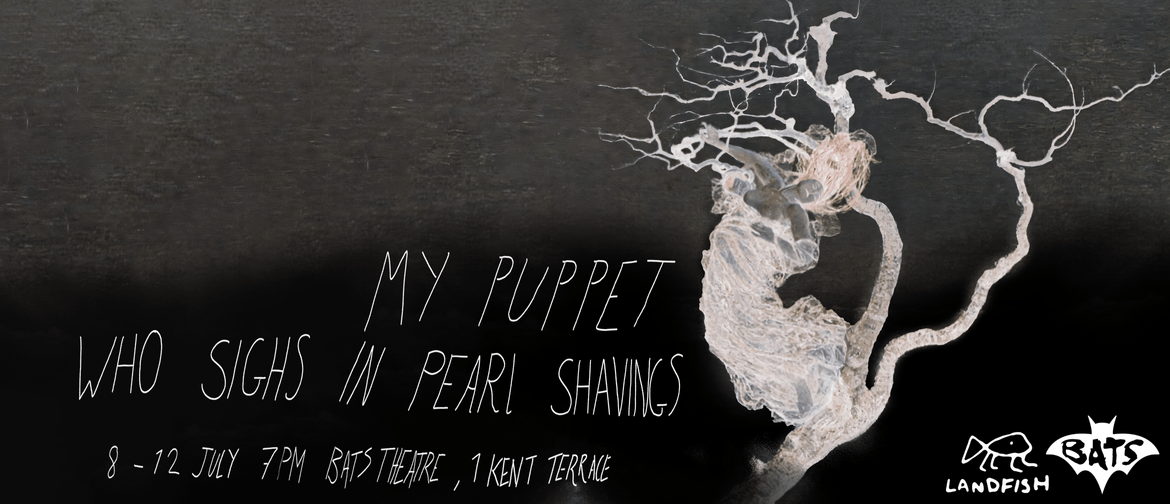Ancient classical lyricism melded with the candour of contemporary poetic storytelling, My Puppet Who Sighs in Pearl Shavings is an entirely queer-led theatre production comprising a single performer (Raven Harvey-Lomas, also the writer), a rich set and costume design (Anne Amber), an atmospheric electronic soundscape (Scarlett Peckham) and a quietly evocative lighting design (Gabriella Eaton). This is the debut show from Landfish Productions.
Emphasising strong themes of duality and identity within the piece, each component sweeps forth in waves, never fully receding until the play’s end. At times, these waves are a cool pearl-white against the quiet rustling of leafless trees; other times, they evoke many hands dropping pebbles onto a beach of the same, to a rising red-pink LED wash. Against these pairings, a single chaise longue sits centre-stage, light mesh curtains hang down, indeed reminiscent of the ‘pearl shavings’ part of the title.
My Puppet Who Sighs in Pearl Shavings begins with Harvey-Lomas’s narrator standing elevated behind the chaise longue, refreshing audiences with the myth of Eros and Psyche. Of their love, of Aphrodite’s jealousy. Of the goddess’s wrath when mortals looked away from her beauty, favouring that of the mortal Psyche.
During the first half of the piece, especially, we are left considering the two-headed lamb, the two-faced bitch, the two faces of humanity. Early on, we are told about the therapist who seems like they “need the money”, and this stood out to me as a particularly prominent statement, given the *climate* of today.
But most of all, I considered the Puppet, and the notion of the puppeteer within the world of the piece. “I carve myself a puppet”, says the puppeteer in Harvey-Lomas’s voice, staging them in a place both real and unreal. But who to really attribute the ‘My’ to in My Puppet? Perhaps it is the gods, referenced with the Eros and Psyche myth, perhaps some more abstract force of nature, as alluded to with the birch marionette, earthquakes, and the pandemic. But then, Harvey-Lomas’s character, revealing herself as being called Cassandra (a prophet in Greek mythology), also draws attention to her self-authorship. This comes after a recalled scene on the therapist’s couch, where Cassandra colloquially describes the choosing of one’s own name as “sexy”, warming us further into the realm of the contemporary.
As we follow Cassandra’s intriguing anecdotes, musings, and contrastingly direct and flowing movements, she wears the ropes of her seemingly discarded marionette strings around her neck and chest. Does this indicate a cosmic abandonment, a cutting loose, a new agency? Does this confirm that this Cassandra is, in fact, both the Puppet and the puppeteer, at the mercy of a prophecy, warning of times to come? This, at least, could be one way to interpret Amber’s evocative costume design. But maybe this is reaching. Maybe this is looking for an explanation, for sense. Maybe that’s the point, for, as Cassandra muses, “the world isn’t really great . . . most of the bones know . . . there’s nothing there to see”.
The Mövenpick Hotel on The Terrace, which was once a COVID-19 isolation facility, where Cassandra (in the narrative present, or past?) is told that she can stay in for a maximum of nine months. ‘Pidgeon Park’ in Te Aro where she fainted one time, and was mistaken for trying to drown in the shallow waters. Lambton Quay, where someone is screaming but no one can see who, or exactly where, it is coming from.
Combined with the abstract and surreal elements, these concrete local settings each contribute their own sort of contemporary mythoi for the anecdotes associated with them. Think conception to incubation to birth, the personal experience versus the misreadings of lookers-on, and the idea of someone else hearing the unearthly cry that you thought only existed in your head. Against the soft electronic siren sound and the motif of a ticking clock in Peckham’s soundscape, there is a real undertone of muffled urgency in the telling. There is a feeling of oncoming change, the anxiety of not knowing who or what we will emerge as on the other side.
But much is left open to interpretation. And the sharp intelligence, creativity and consideration gone into Landfish Production’s debut show seems to trust the imaginations of the audience. It also, perhaps, offers a voice—or voices—for what many of us have been feeling.
My Puppet Who Sighs in Pearl Shavings was staged at BATS Theatre in Pōneke from 8–12 July 2025. Regardless of whether we will be granted a return season, I look forward to seeing what Landfish Productions will create next.



